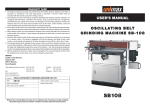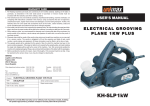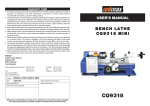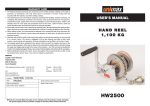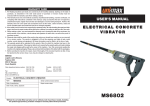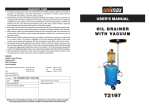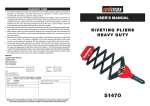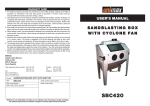Download RAPSB20
Transcript
??? CARD WARRANTY 1. KH Trading machines and tools are covered by 6/24 months warranty, starting on the date of purchase, as described in the Civil Code (proof of purchase or invoice receipt must be enclosed with the warranty card when making a claim). 2. This warranty does not cover defects caused by unprofessional handling, machine overloads, not complying with instructions contained in this manual, using accessories that are not approved, unauthorized repair, regular wear and tear and damages occurred during transport. Further, this warranty does not cover parts and accessories such as the motor, carbon brushes, seals and hot-air operated parts and parts that need to be changed regularly. 3. If the repair is to be found as not covered by the warranty policy, all costs including the repair and shipping to and from the repair centre will be paid by the customer, according to valid price list. See www. 4. When making a claim, you must present the warranty card, showing the date of the purchase, the serial number of the machine, vendor stamp and signature of sales clerk, as well as the proof of purchase receipt. 5. Warranty claim shall be made at the vendor shop where you bought your machine or you may mail it to a service centre. The vendor is obligated to fill out the warranty card (date of sale, serial number, vendor stamp and signature). All these information must be filled in at the time of sale. 6. The warranty period will be extended for the period of time for which the machine has been in the service centre possession. If the repair or defect is not covered by the warranty policy, all costs including the repair and shipping will be paid by the owner of the machine / tool. We recommend sending the machine in its original packaging. Please, also enclose brief description of the defect with the packaging. 7. Before sending the machine for repair, clean it thoroughly. If the received machine is dirty, it may be rejected by the service shop or you may be charged a cleaning fee. USER'S MANUAL BLASTING UNIT OSB - 20 SERVICE Logistic centre Klecany Topolová 483 250 67 Klecany Czech Republic Claim department phone number: 266 190 156 266 190 111 Fax: 260 190 100 http://www.KHnet.cz Email: [email protected] Product: Type: T-mobile: 603 414 975 O2: 601 218 255 Vodafone: 608 227 255 PRESSURE BLASTING UNIT OSB -20 Serial number (product series): RAPSB20 Date of manufacture: Repair centre notes: Date of sale, stamp, signature: RAPSB20 Without the correctly filled warranty card or without proof of purchase receipt, including the product type (invoice, purchase receipt) no warranty claim will be processed. Dear customer. Thank you for purchasing equipment from KH Trading, s.r.o. Our company is ready to offer you our services - before, during and after you buy our product. If you have any question, comment or idea, please contact our business centre. We will do our best to address your comment or question in timely matter. Before first use, please read this manual carefully. It is your responsibility to study all instructions, necessary for safe use and operation and to understand all risks that may be involved during the use of power machines. WARNING! Do not try to use this machine before reading this entire manual and before you know how to handle it. Keep this manual for future reference. Pay special attention to safety instructions. Not complying with safety rules may cause injury to the operating person or to people standing by or it may cause damage to the machine or to the work piece. Pay special attention to safety notes and safety labels on the machine. Never remove or damage them. Please, write information such as the invoice number and the number of the sale receipt here in this box. DESCRIPTION During pressure blasting, the sand or blasting substance is not being mixed in the pistol chamber, but the entire blasting substance reservoir is pressurized. The air and blasting substance mixture is carried through a rubber hose with double-layer textile reinforcement to the conical nozzle. This method offers up to 30% increase in blasting efficiency. TECHNICAL SPECIFICATION Volume of the pressurized reservoir . . . . . . . . . . . . . . . . . . . . . . . . . . . . . . . . . . . . . . . . . . . .92 litres Operational pressure . . . . . . . . . . . . . . . . . . . . . . . . . . . . . . . . . . . . . . . . . . . . . . . . . . . . .6 - 10 bar Air consumption . . . . . . . . . . . . . . . . . . . . . . . . . . . . . . . . . . . . . . . . . . . . . . . . . . .170 - 700 l.min.-1 Dimension (h x d x w) . . . . . . . . . . . . . . . . . . . . . . . . . . . . . . . . . . . . . . . . . . . . . . .84 × 35 × 45 cm Gross weight . . . . . . . . . . . . . . . . . . . . . . . . . . . . . . . . . . . . . . . . . . . . . . . . . . . . . . . . . . . . . .28 kg The accuracy of instructions, graphs and information contained herein, depends on the printing date. Due to continuous product improvement, the manufacturer reserves the right to change technical parameters of the product, without prior customer notification. 2 REPAIR AND MAINTENANCE REPORT Report and maintenance report: DATE REPAIR AND MAINTENANCE REPORT SERVICE SHOP ??? SAFETY PRECAUTIONS • This device may be used by a qualified person, 18 years or older who has been trained in work and environmental safety procedures. • Any person using this equipment must possess a medical certificate demonstrating his eligibility to operate this equipment. Self-adhesive safety symbols labels used with your machine: Use protective gloves Harmful or irritable substances Use protective working shoes Read manual before use Use ear protection Use respiratory passageways protection Use protective helmet Use protective clothing Place the self-adhesive stickers on noticeable spots on your machine. Symbols used in this manual Warning! This symbol informs you about the risk of personal injury or damage to the machine or materials. Warning! Danger of damage. Note: Additional information. Use personal safety gear. General instructions • Make sure you know how to control your tool or machine and that you are familiar with its operating procedure. Know the hazards that may occur, if not used correctly. • If other person is using this machine make sure that he knows how to safely operate this equipment and that he is familiar with hazards and risk that may occur, if not used correctly. • Pay special attention to safety notes and safety labels on the machine. Do not remove or damage them. If the warning label becomes unreadable, please contact your vendor. • Dirty and disorganized workplace may cause accidents. • Never work in poorly lit, narrow or too crowded rooms. Always keep stable posture. • Maintain your tools clean and in safe working conditions. • Handles must be kept free of grease and dirt. • Make sure no children, unauthorized persons or animals have access to your workshop. • Use only for purposes for which it has been designed. • Use personal protective gear such as safety goggles, ear protection, respirator, safe working shoes etc. 3 • • • • • • • • • • • • • • • • • • • Do not overreach, use both hands. Never work under the influence of alcohol or other drugs. Do not use the machine/tool if you feel dizzy or week. Any modifications or improvements to the machine are strictly prohibited. DO NOT USE if you discover bent part, crack or other damage. Never perform any maintenance during operation. If you see any unusual sign or hear any strange sound, switch off the machine immediately. Make sure to remove all wrenches and screwdrivers from the machine after use. Before use, make sure all screws are tightened securely. Perform maintenance regularly. Before use make sure the machine is in good working conditions and without any damage. Use only original spare parts during repairs. Using extension pieces or accessories not approved by the manufacturer may cause injuries to the operating personnel. Use suitable tool for particular type of work. Do not overload tools, accessories or the machine. For large work volume use more powerful machine. Do not overload your device. Measure the work load in such way, so it could be done with comfortable speed. Damages due to machine overload are not covered by the warranty policy. Do not expose to extremely high temperature or direct sunlight. This machine is not designed for use in humid environments or under water. If you are not using your machine, store it in a dry and locked place, out of reach of children. Before use make sure that all safety elements work correctly and efficiently. Make sure all moving parts are in good working conditions. Before use make sure that no part is cracked or stuck, Make sure all parts are attached and assembled as designed. Also take into consideration other conditions that may have a negative effect on the proper function of your machine. If not stated otherwise in this manual, all damaged parts and safety elements must be repaired or changed. Position Description Number of pieces 31 Screw ST4.2×12 2 32 Upper body 1 33 Spring 1 34 Trigger 1 35 Elastic stud 1 36 Nut M3 1 37 Screw M3×25 1 38 Hardened alloy seal 1 39 Rubber seal 1 40 Adapter 1 41 Seal 1 42 Ceramic nozzle 1 43 Rubber reduction piece 1 44 Nozzle nut 1 Assembly • Do not use the machine unless completely assembled. Compressed air • Te supplied air must be compressed according to the required specifications. The airflow supply must be sufficient. Higher supply pressure decreases the life expectancy of the machine and increases the possibility of injuries. • Inspect the compressor air-intake filter regularly. If the power of the compressor decreases or if the filter is dirty, change it immediately. Using compressor with dirty or clogged filter may cause irreversible damages to your compressor. • The coupling that connects the machine with the supply apparatus must have the prescribed dimensions. • Use extra caution when working in humid environments. Water and humidity may clog the pressure hoses and/or the nozzle. If you have to work in humid environment, do not forget to drain the water from the pressurised air tank of your compressor. Do not forget to clean the inside of the pressure hose with compressed air to remove water from the hose. • Observe the water level in the water separation unit and empty it regularly. • Make sure no dirt can enter the inside of the machine. Keep inlet and outlet openings clean. • Before uncoupling compressed air piping or hose, turn off the air pressure supply. Wait until the pressure equalizes. 4 13 PART LISTING Position Description Number of pieces 1 Lid 1 2 Handle 1 3 Reservoir 1 4 Hood 1 5 Pressure gauge 1 6 Safety valve 1 7 Nipple 5 7A Nipple 1 8 Feed piping 1 9 6HR nut 2 10 Washer 2 11 Screw 2 12 Water and sediment separation unit 1 13 Hose 1 14 Brass inlet valve 3/8" 1 15 Coupling 1 16 Srew M8×10 4 17 Bottom support flange 1 18 Steel blasting substance control valve 2 19 Pipe 1 20 Arm 2 21 Washer 4 22 Wheels 2 23 Axis 1 24 Safety pin 3 25 Hose 1 26 Hose clip 2 27 Coupling 1 28 Lower body 1 29 Screw ST4.2×16 4 30 Steel pipe 1 12 • Before starting your work, inspect all couplings and piping for leakage. If leak is found repair it immediately. Leakage puts an extra strength on the compressor and increases the operational cost. • Inspect the pressure hoses and piping system regularly. If you discover a leakage during work, stop working immediately. Have the defective part repaired or changed for a new one. Pressure hoses may not be twisted. Observe the line on the hose surface. Hoses marked like that must be kept as straight as possible. • Pressure hose couplings must be secured with safety clips. It is prohibited to use pressurized couplings without the safety clips properly installed. • Do not run the pressure hoses over sharp edges or through places where they may be damaged or cut. • Before installing a new hose blow compressed air through it first. • If you have to run the hose through various structures, use bushings to protect the hose from damages. Inspect the hose regularly. • Use protective caps and plugs to prevent dirt from entering the system. Sandblasting • Before use make sure you know how to operate your machine. Study the user's manual for this machine, as well as manuals for the air compressor and other tools or machines you may be using with the sandblasting equipment. Also make sure that the place where you will be using your machine (or even the work piece) is not covered by special safety rules and regulations. If so, study them carefully. • Keep your working place clean. • Do not use the blasting equipment or the compressor close to flammable or explosive gases or liquids. • Do not allow children to access your workplace. Anyone who is present to the blasting procedure must wear the same protective gear as the person operating the blaster. • Use the prescribed protective gear and clothing. Use the supplied protective gloves, dust protection mask and hood if necessary. • Inspect the sandblasting unit regularly. CAUTION - exposed parts of the sandblasting equipment get worn out inside so you may not notice their condition at first. Failure of such parts may cause severe damages. • Change dirty and worn out abrasive substance. • Inspect the blasting and the air nozzle. Change it for new one if needed. If you use worn out nozzles you may damage the pistol. • Inspect all parts of your machine that may be worn out due to the abrasive substance impact. • If you sandblasting small parts, use suitable clamping device to hold them down securely and to have both your hands available for valve and nozzle control. • Do not overestimate your abilities. • Always use protective shoes, clothing, respirator, gloves and hood. • Maintain your tools in good working conditions. • Before performing maintenance or if you are not using your equipment, disconnect the compressed air supply. • Make sure the machine may not be switched on accidentally. • If you are not using your machine, close all valves. • Pay attention during work - do not work if you are tired. • Use only original spare parts during repairs. • Change the protective foil and gloves. Power equipment • Before performing any maintenance on air-operated equipment, lower the air pressure in the system gradually. Observe the pressure gauge and make sure that it reads 0 before performing any maintenance. • If your machine is equipped with depressed springs, use suitable device to release them slowly and safely. 5 ASSEMBLY DETAILED PART DRAWING • Before throwing the packaging material out, make sure no part is left inside. If so, take it out and install it. Use the part listing for check-up and the installation drawing for guidance. • To seal threading couplings use teflon tape. • Your machine is delivered pre-assembled. • Assemble your machine in accordance with drawings or pictures included in the manual. • Couplings blasting unit/hose and hose/blasting pistol must be secured with safety clips. Using your machine without the coupling safety clips is prohibited. You may damage the machine or injure yourself. When you finished assembling your machine, perform leakage test and inspection according to the following steps: Inspection of reservoir couplings for leakage. • Close the valve 14 - the control lever must be perpendicular to the valve body. • Close both valves 18 under the pressure gauge. Also close the sandblasting substance feed in the lower part of the reservoir. The control lever must be perpendicular to the valve body. • Connect the compressed air supply hose to the inlet 15 and secure it in place with the safety clip (not included). • Place seal on the lid of the basting substance reservoir. • Using one of your hands, close the opening of the blasting substance reservoir with the lid 1. Pull the lid slightly upwards to make sure that it is closed tightly. • With your other hand, slowly open the valve 14. • Observe the rising pressure inside the reservoir on the pressure gauge 5. • Close the valve 14. • Observe the pressure decrease on the gauge. The pressure gauge must show the same value constantly. • If you suspect a leakage, use water with soup or your ears to detect the location of the leak. Once you located the leak, mark it down. • Let the air our of the system as follow. • Slowly open the valve 18 under the pressure gauge 5. • Slowly press the trigger of the blasting pistol to let the air pressure out of the reservoir. 6 11 • New working hose has its walls made out of two 6 mm thick reinforcing cords. The flow of the abrasive substance makes its walls thinner and therefore must be changed when needed. • The system may be checked for leakage using procedure described in the Assembly chapter. • If you discover any small leak, stop working immediately and decompress the system. Then change the defective part. • Also make thorough inspection of all remaining parts of the system. • When you finished repairs, inspect the system for leakage again, using procedure described earlier. Detailed description of the use of this device is not included in this manual, because the manufacturer / distributor assumes that the user is experienced in similar type of work. Also according to the applicable law, this device is considered as a commonly sold and used tool. If the user is unfamiliar with the use of this device, we recommend finding out more information about using this device at the Department of work safety. DISPOSAL When the operational life of your device is over, dispose off it in accordance with valid rules and regulations. Your product is made of metal and plastic parts that may be recycled when separated. 1. 2. Disassemble all parts. Separate all parts according to the material they are made of (e.g. metals, rubber, plastics, etc.). Take the separated parts to the recycling facility near you. Information about the locations of recycling centres may be found at your local City office or throughout an Internet search. CAUTION If the machine breaks down, send it back to the vendor for quick repair. Please, enclose brief description of the defect. That makes repair easier. If the machine is still covered by warranty, enclose the warranty card and proof of purchase receipt. After the warranty period expires, we repair your machine for a special price. To prevent possible damages during shipping, packed the machine carefully or use the original packaging material. We are not liable for shipping damages due to incorrect packaging of your machine. If making a claim at the shipping company the level and method of packaging plays a major role during claim evaluation process. Note: Pictures and contents in this manual may slightly differ from the actual product or accessories. It is due to continuous improvement of our products. Such small differences have no effect on the product functionality. 10 • Look at the pressure gauge 5 to make sure that there is no pressure in the reservoir. • Coupling that leaks must be tightened again. If that is not enough, unscrew them and use more teflon sealing tape. • After you repaired all leaks, repeat the inspection as described earlier. Accessories leak inspection. • Open both valves 18. • Using one of your hands, close the opening of the blasting substance reservoir with the lid 1. Pull the lid slightly upwards to make sure that it is closed tightly. • With your other hand, slowly open the valve 14. • Observe the rising pressure on the pressure gauge 5. • When you reach operational pressure in the system, close the inlet valve 14. • Observe the pressure decrease on the gauge. The pressure gauge must show the same value constantly. • If the pressure decreases, there is a leak in the system somewhere and it must be repaired. • Inspect the following parts for leakage: 7, 7A, 13, 19, 25, 26, 27, 39, 40, 41, 42, 43, 44. • If you suspect a leakage, use water with soup or your ears to detect the location of the leak. Once you located the leak, mark it down. • Slowly press the trigger of the blasting pistol to let the air pressure out of the reservoir. • Look at the pressure gauge 5 to make sure that there is no pressure in the reservoir. • Coupling that leaks must be tightened again. If that is not enough, unscrew them and use more teflon sealing tape. • Once you repaired all leaks, repeat the inspection as described earlier again. Pay special attention when performing leakage inspection as it is very important. Each even a small leak increases the operational cost, overloads the compressor and may cause damages. OPERATION • Protect the compressor from the sandblasting substance particles. The compressor takes large volume of air during operation and its filter is not capable of eliminating all particles from being taken in. • If abrasive particles get inside the compressor, it will cause irreversible damage to your compressor. If possible, place the compressor in different room. Or if working outside, place the inlet of the compressor in the same direction as the wind blows. • Use sufficient length of the supply hose with the correct inner diameter to support the airflow. Compressed air requirements. Sandblasting process consumes huge amount of compressed air. The efficiency of the blasting process may be significantly reduced if you are using hose with insufficient inner diameter, low air pressure, or too large nozzle diameter. Here is a chart showing the relationship between the length of the hose, the diameter of the hose and the diameter of the nozzle. 7 The nozzle diameters are only for reference. Not supplied. Inner diameter of the supply hose 3/8” 3/8 ” 1/ ” 2 1/ ” 2 length of the supply hose 15 m 7.5 m 15 m 7.5 m nozzle diameter compressor power 2.54 mm 3.18 mm 3.81 mm 4.45 mm output (at 8 bar pressure) 1.5 kW 3 kW 5 kW 7.5 kW air consumption per hour 170 l/min 340 l/min 570 l/min 710 l/min abrasive substance consumption 27 kg 46 kg 68 kg 91 kg We recommend using compressed air between 6 - 8 bar Choosing the right abrasive substance. • The right abrasive substance significantly affects the productivity and the efficiency of the blasting process. You may use economical materials such as sand, for example. Nevertheless, saving cost in such way causes number of other (technical) problems. Regular sand (even if cleaned thoroughly) contains dirt particles and organic particles that absorb humidity. Wet abrasive substance may clog or damage the nozzle or valves of your machine. Therefore, we recommend using synthetic blasting substances to eliminate such problems. • When you are reusing blasting substance, keep in mind that sharp edges of the abrasive particles get worn out (dulled) and thus reducing the efficiency of the blasting process. To keep your machine in good working conditions and to comply with safety rules do the following regularly: • Change dirty and worn out abrasive substance. • Inspect the blasting and the air nozzle. Change it for new one if needed. If you use worn out nozzles you may damage the pistol. • Inspect all parts of your machine that may be worn out due to the abrasive substance impact. • Change the protective foil and gloves. Opening the abrasive substance reservoir. • Before opening the abrasive substance reservoir, close the valve 18 located on the lower part of the reservoir. • Press the handle shortly to blow out the remaining blasting substance from the hose. • Close the valve 14 and press the handle briefly again to let the compressed air from the reservoir. • Make sure that the pressure gauge reads zero pressure and open the reservoir. Note: After the pressure is completely released the lid will fall inside the reservoir. • Use only the maximum allowed air pressure. 8 bar. If higher pressure is reached, the extra pressure shall be let out by the safety valve 6 - if the valve does not switch on when higher pressure is reached, stop working immediately and lower the pressure in the reservoir to zero. Then you may try to find the reason for the malfunctioning. 8 Filling the reservoir with abrasive substance. Open the lid of the reservoir. Follow the procedure described earlier in the article OPENING THE ABRASIVE SUBSTANCE RESERVOIR. There must not be any pressure left in the reservoir and the pressure gauge must read 0. Then you may open the lid. • Before filling the substance in make sure, that the substance is dry, that the particle size and the type will not clog the outlet valve at the lower part of the reservoir, the hose, blasting pistol etc. • Wear suitable protective clothing. • Close the substance feed valve in the bottom part of the reservoir. • Pour the abrasive substance in the reservoir. The upper part of the reservoir is shaped like a funnel, which makes the refilling procedure easier. • Try to pour sufficient amount of the substance inside the reservoir to be able finish the blasting process without needing to refill the substance again. • If you will be blasting large surfaces, do not fill the reservoir more than 75% of the volume. Do not forget to let the pressure out of the reservoir before refilling. Follow the steps described earlier. Also drain the condensed water from the sediment separation unit or the humidity may get inside the reservoir and make the substance wet, which can then clog the valves, blasting pistol or the hose. • Inspect the amount of the condensed water in the sediment separation unit during work as well, mainly when the humidity of the environment is high. • When you refill the reservoir, clean the lid seal from abrasive substance residue and close it by pulling it upwards. • Slowly open the inlet valve and observe the rising pressure in the reservoir. • Make sure there is no leak of the compressed air from the reservoir (under the lid) as soon as you start to pressurize it. • Press the outlet nozzle briefly to blow-clean the piping. • Open the substance feed valve in the bottom part of the reservoir. • You may now use your machine. Press the blasting pistol trigger and start working. Finishing the sand blasting process • Close the substance feed valve in the bottom part of the reservoir. • Press the blasting pistol trigger briefly to clean any substance residue from the hose. • Close the inlet valve 14. • Press the handle to let the remaining pressure out of the reservoir. The pressure gauge must read 0. • Close all remaining valves due to security reasons. MAINTENANCE • • • • • • Keep your tools clean. Dirt may enter the inner mechanism of your machine and cause damage. Do not use aggressive cleaning solution or paint thinners to clean the machine. Clean plastic parts with cloth dipped in soup water. Clean and lubricate metal surfaces with a cloth dipped in paraffin oil. If you are not using your machine, lubricate it with suitable grease and store it in a dry place to prevent corrosion. Parts of the blasting equipment that are in contact with the blasting substance wear out quickly. These are mainly: the hose, inlet valve and the nozzles. Inspect these parts regularly for wear and tear damages and change for new ones if needed. • Damages may not be noticeable on the part surface. 9









